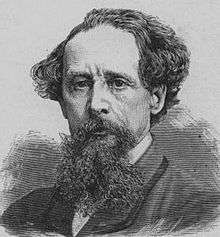The Pickwick Papers
The Posthumous Papers of the Pickwick Club (also known as The Pickwick Papers) was Charles Dickens's first novel. Because of his success with Sketches by Boz published in 1836 Dickens was asked by the publisher Chapman & Hall to supply descriptions to explain a series of comic "cockney sporting plates" by illustrator Robert Seymour,[1] and to connect them into a novel. The book became Britain's first real publishing phenomenon, with bootleg copies, theatrical performances, Sam Weller joke books, and other merchandise.
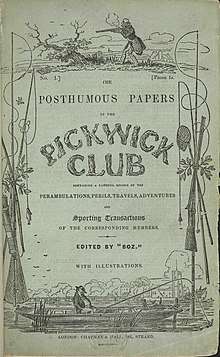 Original cover issued in 1836 | |
| Author | Charles Dickens ("Boz") |
|---|---|
| Original title | The Posthumous Papers of the Pickwick Club, Containing a Faithful Record of the Perambulations, Perils, Travels, Adventures and Sporting Transactions of the Corresponding Members |
| Illustrator | Robert Seymour Robert William Buss Hablot Knight Browne (Phiz) |
| Country | England |
| Language | English |
| Subject | Travels in the English Countryside |
| Genre | Novel |
| Published | Serialised March 1836 – November 1837; book format 1837 |
| Publisher | Chapman & Hall |
| Media type | |
| Preceded by | Sketches by Boz |
| Followed by | Oliver Twist |
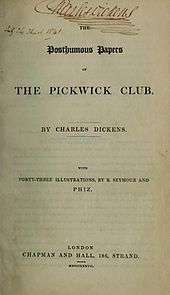
Seymour's widow claimed that the idea for the novel was originally her husband's, but Dickens strenuously denied any specific input in his preface to the 1867 edition: "Mr Seymour never originated or suggested an incident, a phrase, or a word, to be found in the book."[2]
Background
Dickens was working as a Parliamentary reporter and a roving journalist at age 24, and he had published a collection of sketches on London life as Sketches by Boz. Publisher Chapman & Hall was projecting a series of "cockney sporting plates" by illustrator Robert Seymour. There was to be a club, the members of which were to be sent on hunting and fishing expeditions into the country. Their guns were to go off by accident, and fishhooks were to get caught in their hats and trousers, and these and other misadventures were to be depicted in Seymour's comic plates.[1] They asked Dickens to supply the description necessary to explain the plates and to connect them into a sort of picture novel that was fashionable at the time. He protested that he knew nothing of sport, but still accepted the commission.[1]
Only in a few instances did Dickens adjust his narrative to plates that had been prepared for him. Typically, he led the way with an instalment of his story, and the artist was compelled to illustrate what Dickens had already written. The story thus became the prime source of interest and the illustrations merely of secondary importance.[1] Seymour provided the illustrations for the first two instalments before his suicide. Robert William Buss illustrated the third instalment, but Dickens did not like his work, so the remaining instalments were illustrated by Phiz (Hablot Knight Browne) who illustrated most of Dickens' subsequent novels. The instalments were first published in book form in 1837.[3]
Summary
.jpg)
The Pickwick Papers is a sequence of loosely related adventures written for serialization in a periodical. The action is given as occurring 1827–28, though critics have noted some seeming anachronisms.[4] For example, Dickens satirized the case of George Norton suing Lord Melbourne in 1836.[5]
The novel's main character Samuel Pickwick, Esquire is a kind and wealthy old gentleman, the founder and perpetual president of the Pickwick Club. He suggests that he and three other "Pickwickians" should make journeys to places remote from London and report on their findings to the other members of the club. Their travels throughout the English countryside by coach provide the chief subject matter of the novel.[6]
Characters
Central characters
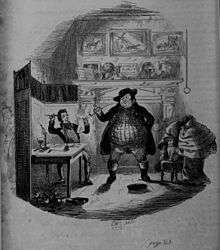
- Samuel Pickwick – the main protagonist and founder of the Pickwick Club. Following his description in the text, Pickwick is usually portrayed by illustrators as a round-faced, clean-shaven, portly gentleman wearing spectacles.
- Nathaniel Winkle – a young friend of Pickwick's and his travelling companion; he considers himself a sportsman, though he turns out to be dangerously inept when handling horses and guns.
- Augustus Snodgrass – another young friend and companion; he considers himself a poet, though there is no mention of any of his own poetry in the novel.
- Tracy Tupman – the third travelling companion, a fat and elderly man who nevertheless considers himself a romantic lover.
- Sam Weller – Mr Pickwick's valet, and a source of idiosyncratic proverbs and advice.
- Tony Weller – Sam's father, a loquacious coachman.
- Alfred Jingle – a strolling actor and charlatan, noted for telling bizarre anecdotes in a distinctively extravagant, disjointed style.[4]
Supporting characters
- Joe – the "fat boy" who consumes great quantities of food and constantly falls asleep in any situation at any time of day; Joe's sleep problem is the origin of the medical term Pickwickian syndrome, which ultimately led to the subsequent description of obesity hypoventilation syndrome.
- Job Trotter – Mr Jingle's wily servant, whose true slyness is only ever seen in the first few lines of a scene, before he adopts his usual pretence of meekness.
- Mr Wardle – owner of a farm in Dingley Dell. Mr Pickwick's friend, they meet at the military review in Rochester. Joe is his servant.
- Rachael Wardle – Mr. Wardle's spinster sister, who tries in vain to elope with the unscrupulous Jingle.
- Mr Perker – an attorney of Mr Wardle, and later of Mr Pickwick.
- Mary – "a well-shaped female servant" and Sam Weller's "Valentine".
- Mrs Martha Bardell – Mr Pickwick's widowed landlady who brings a case against him for breach of promise.
- Emily Wardle – one of Mr Wardle's daughters, very fond of Mr Snodgrass.
- Arabella Allen – a friend of Emily Wardle and sister of Ben Allen. She later elopes with Mr. Winkle and marries him.
- Benjamin "Ben" Allen – Arabella's brother, a dissipated medical student.
- Robert "Bob" Sawyer – Ben Allen's friend and fellow student.
Adaptations
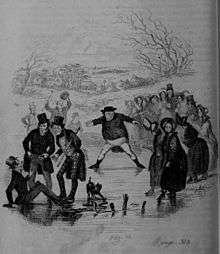
The novel has been adapted to film, television, and radio:
- 1913 – The Pickwick Papers, a silent three-reel film featuring John Bunny as Samuel Pickwick
- 1921 – The Adventures of Mr. Pickwick, silent, lost, starring Frederick Volpe and Hubert Woodward
- 1936 – On 13 November 1936 (less than two weeks after the BBC began regularly scheduled television broadcasts) The British Music Drama Opera Company under the direction of Vladimir Rosing presented the world's first televised opera: Pickwick by Albert Coates.[7]
- 1938 – 'The Pickwick Papers', Orson Welles's Mercury Theater on the Air radio adaptation (20 November 1938)[8]
- 1952 – starring James Hayter, Nigel Patrick, Alexander Gauge and Harry Fowler (the first sound film version, and to this day, the only sound version of the story released to cinemas)
- 1985 – an animated adaptation
In 1985 BBC released a 12-part 350-minute miniseries starring Nigel Stock, Alan Parnaby, Clive Swift and Patrick Malahide.
According to Retrospect Opera, there was an early attempt at a theatrical adaptation with songs by W.T. Moncrieff and entitled Samuel Weller, or, The Pickwickians, in 1837. This was followed in 1871 by John Hollingshead's stage play Bardell versus Pickwick. The first successful musical was Pickwick (sometimes Pickwick, A Dramatic Cantata) by Sir Francis Burnand and Edward Solomon and premiered at the Comedy Theatre on 7 February 1889.[9]
Pickwick by Cyril Ornadel, Wolf Mankowitz, and Leslie Bricusse was a musical version which premiered in Manchester in 1963 before transferring to the West End. It originally starred Harry Secombe (later cast as "Mr Bumble" in the film version of Oliver!) in the title role and Roy Castle as "Sam Weller". Although it was a major success in London, running for 694 performances, Pickwick failed in the United States when it opened on Broadway in 1965. In 1969, the BBC filmed the musical as the TV movie Pickwick with Secombe and Castle reprising their stage roles. Both the stage and TV versions featured the song If I Ruled the World, which became a hit for Secombe and other singers such as Tony Bennett and Sammy Davis Jr..
Part of The Pickwick Papers were featured in Charles Dickens' Ghost Stories, a 60-minute animation made by Emerald City Films (1987). These included The Ghost in the Wardrobe, The Mail Coach Ghosts, and The Goblin and the Gravedigger.
Stephen Jarvis's novel Death and Mr Pickwick[10] (2014) is in part a literary thriller, examining in forensic detail the question of whether the idea, character and physiognomy of Samuel Pickwick originated with Dickens, or with the original illustrator and instigator of the project, Robert Seymour. The conclusion of the narrator is that the accepted version of events given by Dickens and the publisher Edward Chapman is untrue.
Publication
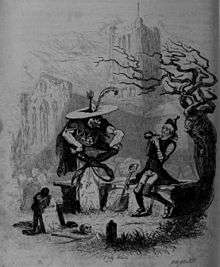
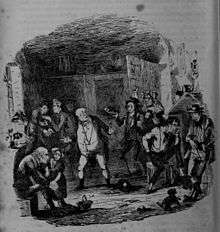
The novel was published in 19 issues over 20 months; the last was double-length and cost two shillings. In mourning for his sister-in-law Mary Hogarth, Dickens missed a deadline and consequently, there was no number issued in May 1837. Numbers were typically issued on the last day of its given month:
- I – March 1836 (chapters 1–2);
- II – April 1836 (chapters 3–5);
- III – May 1836 (chapters 6–8);
- IV – June 1836 (chapters 9-11);
- V – July 1836 (chapters 12–14);
- VI – August 1836 (chapters 15–17);
- VII – September 1836 (chapters 18–20);
- VIII – October 1836 (chapters 21–23);
- IX – November 1836 (chapters 24–26);
- X – December 1836 (chapters 27–29);
- XI – January 1837 (chapters 30–32);
- XII – February 1837 (chapters 33–34);
- XIII – March 1837 (chapters 35–37);
- XIV – April 1837 (chapters 38–40);
- XV – June 1837 (chapters 41–43);
- XVI – July 1837 (chapters 44–46);
- XVII – August 1837 (chapters 47–49);
- XVIII – September 1837 (chapters 50–52);
- XIX-XX – October 1837 (chapters 53–57);
Models
Dickens drew on places that he knew from his childhood. He located the duel between Mr. Winkle and Dr. Slammer at Fort Pitt, Chatham,[11] close to Ordnance Terrace where he had lived as a boy between 1817 and 1821.[12]
Influences and legacy
The popularity of The Pickwick Papers spawned many imitations and sequels in print as well as actual clubs and societies inspired by the club in the novel. One example is the still in operation Pickwick Bicycle Club in London, which was established in 1870, the same year as Charles Dickens' death.[13] Other clubs, groups, and societies operating under the name "The Pickwick Club" have existed since the original publication of the story.
In 1837, Charles Dickens wrote to William Howison about the Edinburgh Pickwick Club. Dickens approved of the use of the name and the celebration of the characters and spirit of the novel. He wrote:
- If a word of encouragement from me, can as you say endow you with double life, you will be the most lively club in all the Empire, from this time; for every hearty wish that I can muster for your long-continued welfare and prosperity, is freely yours. Mr Pickwick's heart is among you always.[14]
Other known clubs include one meeting as early as December 1836 in the East of London and another meeting at the Sun Tavern in Long-acre in London. Dickens wrote to the secretary of the latter club in 1838 about attending a meeting:
- If the dinner of the Pickwick Club had been on Monday Week, I would have joined it with all the pleasure which you will readily imagine this most gratifying recollection of my works by so many gentlemen, awakens in my mind.[15]
In many Pickwick Clubs, members can take on the names of the characters in the novel. The website for the Pickwick Bicycle Club states "Our rules state that 'Each Member shall adopt the sobriquet allocated by the Management Committee, being the name of some male character in the Pickwick Papers, and be addressed as such at all meetings of the Club'."[16] Imitations/plagiarisms published at the same time as Dickens's Pickwick Papers include G. W. M. Reynolds's Pickwick Abroad; or, The Tour in France.[17]
See also
- Pickwickian syndrome
- The George and Vulture
- The Spaniards Inn
- The Moosepath League books of Van Reid are a tribute to the Pickwick Papers with thoroughly Pickwickian characters. In chapter four of Cordelia Underwood, Cordelia finds a copy of the Pickwick Papers in her uncle's chest.
- Wellerism
References
- This article incorporates text from a publication now in the public domain: Cross, Wilbur L. (1920). . In Rines, George Edwin (ed.). Encyclopedia Americana.
- C. Dickens, The Posthumous Papers of the Pickwick Club (1867 reprint), p.8
- Dickens, Charles. The posthumous papers of the Pickwick Club. Open Library. OL 23001437M.
- Mark Wormald (2003) "Introduction" to The Pickwick Papers by Charles Dickens. London, Penguin.
- "Caroline Norton: A Biographical Sketch", Dr Andrzej Diniejko. Victorian Web.
- Mark Wormald (2003) "Introduction" to The Pickwick Papers by Charles Dickens. London, Penguin
- Herbert, Stephen A., History of Early Television Vol 2., (2004), p. 86-87. Routledge.
- "The Milwaukee Journal - Google News Archive Search". news.google.com. Retrieved 22 March 2018.
- "Retrospect Opera". www.retrospectopera.org.uk. Retrieved 22 March 2018.
- Stephen Jarvis, Death and Mr Pickwick, Jonathan Cape, London, 2014 (ISBN 9780224099660)
- Dickens, Charles. The Posthumous Papers of the Pickwick Club, p 25. Works of Charles Dickens. Avenel Books, 1978.
- Callow, Simon. Charles Dickens and the Great Theatre of the World, p 9. Vintage Books, 2012.ISBN 978-0-345-80323-8
- "The Pickwick Bicycle Club". The Pickwick Bicycle Club. Retrieved 9 December 2016.
- House, Madeline; Storey, Graham, eds. (1965). The Letters of Charles Dickens Volume 1. Oxford: The Clarendon Press. pp. 346–347.
- House, Madeline; Storey, Graham, eds. (1965). The Letters of Charles Dickens Volume 1. Oxford: The Clarendon Press. p. 398.
- /Pickwick Bicycle Club
- Pickwick Abroad here: Pickwick Abroad

External links

| Wikimedia Commons has media related to The Pickwick Club. |
| Wikiquote has quotations related to: Pickwick Papers |
| Wikisource has original text related to this article: |
Source editions online
- The Pickwick Papers at Project Gutenberg.
- The Pickwick Papers, HTML version
- The posthumous papers of the Pickwick Club by Charles Dickens; with forty-three illustrations, by R. Seymour and Phiz., 1st edition at the Internet Archive
Other online books
- Dickens, Charles. The Pic-Nic Papers. London, H. Colburn, 1841.
- Fitzgerald, Percy Hetherington. The history of Pickwick; an account of its characters, localities, allusions and illustrations, with a bibliography. London: Chapman and Hall. 1891.
- Fitzgerald, Percy Hetherington. Pickwickian manners and customs. Westminster: Roxburghe Press. 1897.
- Grego, Joseph. Pictorial Pickwickiana; Charles Dickens and his illustrators. With 350 drawings and engravings Volume 1 and Volume 2. London Chapman and Hall. 1899.
- Neale, Charles Montague. An index to Pickwick, 1897. Index of words, characters, places.
- Matz, B. W. The inns & taverns of "Pickwick" (C. Scribner's Sons, 1921).
Resources
- The Pickwick Papers Bibliography, from the Dickens Project at the U of CA
- The Pickwick Papers, from The Victoria Web
- Similitudes between Pickwick Papers and Don Quixote, from 'Dickens Quarterly'
- An essay on The Pickwick Papers by G. K. Chesterton
